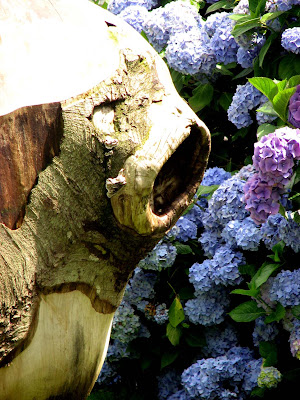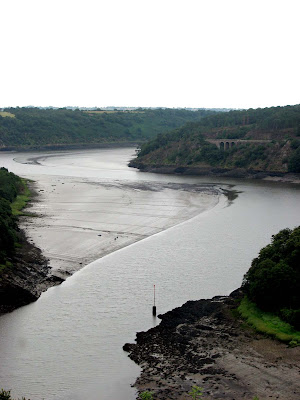It's justifiably held up as a jewel in the sight-seeing crown of Côtes-d'Armor; the building is imposing, the exhibitions held inside, a different one every year, from archaeology to lighthouses to contemporary costarmorican artists (this year's) are of high quality and often fascinating, and best of all are the gardens and grounds, which are entirely free to enter. There are miles of excellent waymarked walks of all kinds; we follow the rough blue ceramic globes which take you on the water walk.

The chateau stands high on the steep banks of the Trieux estuary, and overlooks a tributary valley. The water that runs abundantly through its landscape has been captured and channelled and shaped and played with and adorned.
 We drop down to the bottom of the stream valley, to where it joins the estuary at a small landing beach, and admire the metal sculptures which surround it.
We drop down to the bottom of the stream valley, to where it joins the estuary at a small landing beach, and admire the metal sculptures which surround it.
 In newer, less fearful times, we have put real and frightening nature to flight. We court and desire nature spirits and their wildness, or think we do. Romantic and creative souls can play with and represent them freely. On the opposite, more shaded bank of the stream valley, as we make our way up, we become aware of these old, shamanic faces, fountaining or dribbling or weeping water from their mouths and eyes,
In newer, less fearful times, we have put real and frightening nature to flight. We court and desire nature spirits and their wildness, or think we do. Romantic and creative souls can play with and represent them freely. On the opposite, more shaded bank of the stream valley, as we make our way up, we become aware of these old, shamanic faces, fountaining or dribbling or weeping water from their mouths and eyes, their chins and noses damp and mossy,
their chins and noses damp and mossy, their jowls sprouting weeds and ivy growth,
their jowls sprouting weeds and ivy growth,
and occasionally, a small offering, like the winkleshell above, placed a crevice of their features. Endearing and wistful, synthetic and emasculated, this modern paganism, in an age of cars and digital cameras, supermarkets and subsidies and nitrates in the water.
 We move up the course of the stream, round the wall with its rivulets of water running down it, into the Crusaders' Garden, made from the site of an old quarry, sheltered and sunny, its planting inspired by the species that would have been encountered and perhaps brought back by returning crusaders from the chateau's earliest days. Despite this rather belligerent theme, it is one of the most cheerful, peaceful spots I know, and I always look forward to reaching it with a sense of gentle joy, and usually pull off shoes, and socks if I'm wearing them, and dip my feet in its pools and runnels.
We move up the course of the stream, round the wall with its rivulets of water running down it, into the Crusaders' Garden, made from the site of an old quarry, sheltered and sunny, its planting inspired by the species that would have been encountered and perhaps brought back by returning crusaders from the chateau's earliest days. Despite this rather belligerent theme, it is one of the most cheerful, peaceful spots I know, and I always look forward to reaching it with a sense of gentle joy, and usually pull off shoes, and socks if I'm wearing them, and dip my feet in its pools and runnels. We continue our progress upstream, it runs over a metal convex cascade like a tyreless wheel rim,
We continue our progress upstream, it runs over a metal convex cascade like a tyreless wheel rim,
into a series of small paved circular pools. The impulse to throw coins into such clear pools is perhaps, I feel, a more genuine and uncontrived survival of a pagan custom, something atavistic and unconscious.

Further on and further up, to the wooded head of the valley. A satiny sheen of duckweed spied through a living trellis of willow fence.

Duckweed abounds here; one of the first times Molly came she got very excited about everything and tried to walk on its apparently solid surface on a small pool, and became temporarily a green dog. Happily, it was a warm day. and the stuff seemed to miraculously all rub off her on the grass after a few good rollings around. She's a little calmer these days.
Suddenly, it appears to rain gently and inexplicably onto a small area of one of these pools; we search for the source of this phenomenon. It is a sprinkler in a high branch of a chestnut tree, the hose feeding it and the pump driving it almost completely concealed. There are several of these odd features in the grounds, timed in some way to go off irregularly, their existence not immediately evident until one is surprised by them.

We double back on ourselves, and emerge back along the drive approaching the chateau. A year or two ago, a fine avenue of beech trees had to be felled because of disease, and a young sculptor (sculptress? is this acceptable still?) was commisioned to make something of the sections of hollow trunk. These ring-shaped forms are simple but beautiful, and much of their attraction is in their positioning, so that one can look through them at different vignettes of the chateau and grounds, or play peek-a-boo through the openings,
 or admire the delicacy of the galled and blackened interiors, the scars of previous lopping or falling of branches,
or admire the delicacy of the galled and blackened interiors, the scars of previous lopping or falling of branches, or the strata exposed as the artist's chainsaw scooped through the layers of wood and bark.
or the strata exposed as the artist's chainsaw scooped through the layers of wood and bark.At the end of our walk, the weather began to deteriorate, which was well-timed. We stopped for an ice-cream at the bar-restaurant's canopied terrace, a welcome rarity. Places of refreshment at heritage and other sites are surprisingly unusual here, and ice cream vans at beauty spots haven't really been invented. Like all such things, this is a two-sided issue; missing such little pleasures being offset against a rather pleasing lack of interest in consumption, competition and commercialism. By then it was cool enough for Mol to settle down in the car, and we went into the chateau.
The exhibition particularly concentrated on local artists working on natural themes. It was good; the austere, high ceilinged rooms lend themselves well as exhibition space. One of the most beguiling artists was a sculptor/sculptress, Corinne Cuenot ( I think... can't find much about her), whose two displayed works were comprised of what must have been miles and miles of fine metal wire, intricately twisted into what looked like leafy patterned lace. They were immediately pleasing, but better still on closer study, when they began to reveal faces, figures, animals and birds, a whole crowd of beings concealing themselves in a wire forest.
Another delightful element, which there never seems to be time to fully enjoy, is a good sized turret room with comfortable furniture, sofas, chairs, textile hangings, all richly coloured, and tables and shelves laden with beautiful books about the theme of the exhibition, local interest etc, where you are quite free to cosy down and spend as much time as you wish. I found some fascinating books on Nils Udo, and other land art, which I could happily have browsed in for hours.
 But even without the exhibition, it's worth paying the 4 euros entrance just to climb the spiral stircases to the top of the building, exploring the galleries and smaller chambers on the way, all dramatically lit,
But even without the exhibition, it's worth paying the 4 euros entrance just to climb the spiral stircases to the top of the building, exploring the galleries and smaller chambers on the way, all dramatically lit,
and to look down the preciptous walls and banks to the mudflats of the widening Trieux river, across to the viaduct where the steam train makes its way up the peninsular between Pontrieux and Paimpol.

And finally, to gape with wonder at the roof space, all completely renovated and new within the last 20 years, but all completely authentic, from the great adzed timber principles, purlins and rafters, to the thick, uneven tawny coloured slates. We love roofs!

( Thanks to Tom, aficionado of roof timbers, who grabbed the camera off me when we drew near to the top floor, for the last picture. Unfortunately, the dramatic lighting didn't make for very successful photographs, and horrible flash destroys all the form!)

12 comments:
(o)
The scenic beauty leaves me speechle--
That was a wonderful tour, Lucy; thank you very much. Now for the question: palms in France?
Lovely - your descriptions make me want to visit the area.
BTW the painted church was similar to two little chapels we saw in Jersey with painted walls/ceilings.
Beautiful. I am a big fan of the 'buy the postcards and photograph the small stuff' theory.
Congratulations on the details, and on refraining from taking the postcard photos. There's something daft and gross about the way people take the postcard photos, as though to prove that they had been there. As you show here there is so much else to see.
Thanks all, and for affirming the needlessness of the postcard photos. I think people mostly aren't quite sure why they are taking photos, do so because they feel they should, prove they've been there indeed, but without love for what they're doing. Tom's brother-in-law on their way back from Spain showed us a very uninspired collection of shots of obvious scenes, all but one, which was simply a detail of a well-made open timber barn, showing its form and construction. I complimented him on it, he was rather embarrassed and apologetic, said he just liked things like that, as though this was something foolish. It was the only picture that shone through as being done with any feeling or real interest, and was by far the best.
As to palms in France, GrannyJ, that particular spot was chosen as being warm and sheltered enough to accommodate more southerly plants, there are aloes and other exotics there too. Palms are to be seen hereabouts as it's quite mild,Gulf Stream etc, though probably a limited range of species, and harsh winters can do for them. A better place for palms is South Devon on the south coast of England!
Beautiful descriptions and lovely photos. Maybe a kitten or two would have made them even better???
Gorgeous!
Another expert tour, Lucy. I love the blue globes to mark the way. So much more elegant than signs!
Absolutely beautiful place - thanks for the fascinating tour and fantastic photos. Another must-see place to add to my too-long list!
Thanks all!
That's the lot (for the moment) of the posts sponsored by the Syndicat d'Initiative de Cotes d'Armor!
Post a Comment